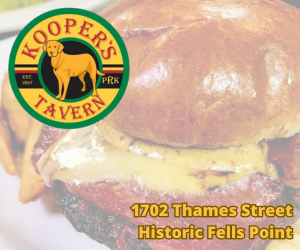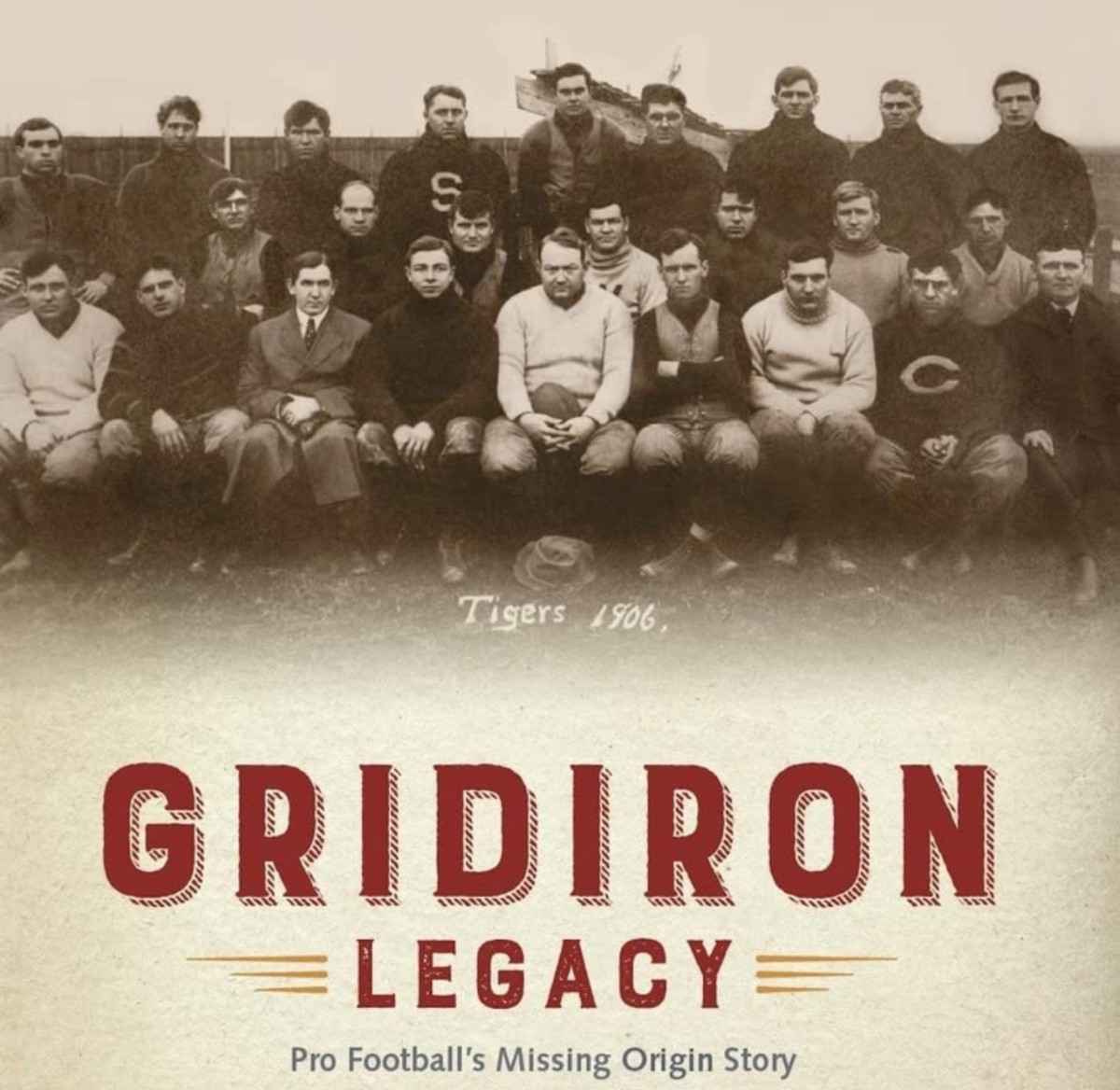Author Gregg Ficery takes Nestor on a century-old tour through the roots of football history in Pittsburgh and Massillon in his new book, “Gridiron Legacy,” which even taught the folks in Canton a few facts about how entrenched organized crime and gambling were at the turn of the 20th century around the emerging sport that took rugby to a different level.
SUMMARY KEYWORDS
pro football, pittsburgh, canton, gambling, football, pictures, fame, great, game, great grandfather, years, book, hall, rivalry, baltimore, athletic club, story, college football, maryland, homestead
SPEAKERS
Gregg Ficery, Nestor Aparicio
Nestor Aparicio 00:01
Welcome back, WN S, T, Towson, Baltimore. And Baltimore positive we are positively getting out and about we’re no city last week doing the Mako thing we’re gonna be moving around on the Maryland crabcakes were presented by our friends at Maryland lottery in conjunction with our friends at win today, she could check out all of the dates and everywhere we’re going to be in the fall at Baltimore positive.com You know, I get books sent to me and as a guy who I read books, I write books, I sort of still like literacy and all that goes along with that and points of view and free speech and even Catcher in the Rye went to New York a couple of weeks ago trying to erase all that stuff. But when I get a big thick book, and I get a history book, I like to take a deeper dive. I didn’t know how to pronounce this guy’s name and this thing came one of the heavier books that I have received. It is grid iron legacy, we’re talking about pro football’s missing origin story and how football started if the late great John Steadman were live he would fact check this for Greg fishery, who is a Steelers fan but we’re not going to get into all those purple and black and gold wars here. I’m going to welcome you on as a friend and as somebody I can learn something from because when I get a book this thick this heavy with this many pictures. Yeah, I’ve been to the Pro Football Hall of Fame bunches and bunches of times, but I’m always looking to learn something Frank, welcome in how are you? Congratulations on getting this thing done, man.
Gregg Ficery 01:24
Good morning Nestor. Thank you. Great to be with you. Well,
Nestor Aparicio 01:27
when I get one this thick and this heavy both of my my published books. Well hardback and paperback Purple Rain wanted Purple Rain, too. There was a point like there was a parade I came back and I’m like, oh, book story, the story behind the story, all of that stuff. When I see these sort of history, things written from a century ago or more. I really understand whoever the author is. There’s a real passion play at work and probably didn’t come up over a couple of beers over the weekend and parole geezer per Manny’s and your case up in Pittsburgh, I would say you probably have been a student of the game for a little while, Greg.
Gregg Ficery 02:03
Since the time I was a sentient being basically my I was aware, from family lore from my mother’s mother, that her father, my great grandfather, Bob shearing, was the greatest center of the pre NFL era. And so I knew early on that there was some pro football before the NFL, but it was very nebulous. It wasn’t some history, but some early history books back in the 70s. There pick some of the team pictures, so I knew it was real. It was a big deal. And as the Internet came around, and I was able to dig deeper, deeper, it became a real passion project and something that went from a genealogy project to kind of a national thing. So here we are.
Nestor Aparicio 02:50
I know all about that, man. You know, I started the news American in 1984 trying to research the 5859 calls. You know how they got here. The all America Conference already Donovan’s walk in the streets and Jim Parker and John Unitas and John Steadman was like a father figure to me and his books on the greatest game ever played, and all of that. So from a Baltimore perspective, it feels like, you know, 4950, and then 54, but really kind of kicked in 58 or 59. And there was no football before then. And then I see Navy, and Maryland and Notre Dame and college football, and even going back to three stooges episodes, you know, in the 20s and 30s, where you’d see them run around with the leather helmets and say, What was sold to college, and then go into the Pro Football Hall of Fame to try to get some history on it, some research on it, the mass salon and like all Canton, Ohio and all that. Where does this come in to all of that, that so many folks have been out for a Ray Lewis induction or John Ogden, or an Ed Reed walked around and said, Well, what’s the story behind the story? And where does a book like this come from? Well,
Gregg Ficery 03:53
that picture on the cover is the 1906 masland Tigers, the world champions. And my great grandfather, Bob sharing there is holding the ball front and center as the captain, the honor that was given to the captains. So that picture hung in my grandmother’s wall. So I knew that at least there’s something
Nestor Aparicio 04:10
you’ve seen this picture from the time you were born, it said, That’s my grandfather, great grandfather, great grandfather, he played football. And that’s all it’s a picture on the wall. That’s what you knew about it.
Gregg Ficery 04:22
The three pictures to from masla 1905 1996. And one that was kind of mysterious. It had an H on their sweaters, but it wasn’t identified. Turned out. It was the homestead library and athletic club from 1901 in Pittsburgh, and they were also world champions. So that was sort of just all I had
Nestor Aparicio 04:43
was like baseball stuff in here, right. Like in this book. This is amazing.
Gregg Ficery 04:47
Well, that was Christy Mathewson, and he was maybe one of the top three pitchers of all time, and he also played college football at Bucknell. So he was sort of Have a PR stunt that they brought him on to the 1902 Pittsburgh professional team to try to save pro football in Pittsburgh, because it wasn’t working out financially. And he was in his
Nestor Aparicio 05:11
team here, folks. They look like Steelers, don’t they? I mean that or pirates one or the other, right?
Gregg Ficery 05:19
They didn’t really have a nickname. Oddly that 1902 team and Mathewson was in that one as well sitting right next to my great grandfather, which is pretty cool.
Nestor Aparicio 05:28
Get these pictures do?
Gregg Ficery 05:30
Family. That’s why I had to do this because I inherited, like 100, like never before published pictures from that era. And I took them to the Hall of Fame. And they, they were just in a, you know, a short meeting turned into a three hour meeting because they just had so many questions. And they ended up saying, Okay, we’re gonna put our cards on the table here. We don’t have any of this stuff. You have an original Constitution here. And we need to show some of these in our exhibits. So let’s work together. And it was the start of a great relationship and the start and they encouraged me to do the book because they said I had something really special. And if I could add the narrative to it of this mysterious cold case of what happened in the 1906 Gambling scandal that ended pro football for 10 years, basically, that it would be an amazing book that nobody else could do.
Nestor Aparicio 06:22
No, you picked a hell of a time to come on. Because if I had the book here, I would grab it, but it’s in the other room. Two weeks ago, I had an author all from Chicago, who found literally everything that was in the court of law from Shoeless Joe Jackson, during that period of time. And I love that story. Yeah, yeah. Well, you know, he’s gone further in and published, literally the court documents that he found and, and talking about gambling, and sports.
Gregg Ficery 06:52
What I did here, I found the court file from the lawsuit that the Canton Bulldogs Captain Blondie Wallace, took out against the Maslin Tigers team and the Maslen newspaper that accused him of colluding in this gambling scandal and he denied it. And but he never got to court because he officially ran out of money. So but I picked up that there was a court file somewhere and I found it and I and I 250 pages of depositions that I sorted through and took the best parts and put in the book. So it really solves for all time that that mystery that’s been hanging out there for over 100 years. It’s really cool.
Nestor Aparicio 07:30
Breakfast Sherry has put together a tomb. It is heavy, and has lots of pictures. It has lots of old stuff. And really the history of football and the beginnings of football, gridiron and legacy pro football is missing origin story. And I would say this for gambling and being sort of the middle of all of this and chicanery and really the criminal underworld a century ago, that now you know, we bet on our phones, the Jetsons wouldn’t believe this right, like where we are, but how organized crime really got its teeth into sports early on and the government got involved and anti Trump like all of these governmental guardrails that were put up because sports has captivated us, I guess, since you know, Roman times. Right. But in our in our modern culture, football even 115 years ago, no NFL none of that. But gambling bubbled up into it. Right.
Gregg Ficery 08:26
That picture you showed of Christy Mathewson actually had a sign on the wall behind them, which was part of the reason I selected that picture said no gambling allowed, like in huge letters on the wall. So they were very aware that of the risks of having gamblers around the game, and they were always around the game. And they were always around football
Nestor Aparicio 08:45
players weren’t making enough money, right $500 could shove you shove anybody at that. I mean, they make price fight movies about that forever, right about throwing the fight. But when it comes to baseball, and football, this was this was big business for the, for the mobsters for criminals. There was a
Gregg Ficery 09:02
story about Cy Young in the first World Series for the Red Sox in 1903 against Pittsburgh that he they tried to offer him a bribe to you know, fix games and lose games on purpose. So of course, they came around and tried to get into these football games as they were starting to become big. And one of the masks on players was infiltrated by some gamblers with $50,000, you know, a big pool to split amongst the players if they were willing to participate. And since my great grandfather was the captain of story I heard as a kid was that he wouldn’t take this bribe and that he reported it to his coach. And they tried to defuse it but it’s still kind of rumors circulated and it all still blew up in a front page story The day after the second of the two championship games between Canton and mass on any. The fallout from that just destroyed the game for 10 years until Jim Thorpe came back around In Kenton resurrected the game, how much of
Nestor Aparicio 10:03
this Did you know sort of firsthand from going into the Pro Football Hall of Fame 20 years ago and like sniffing around a little bit, and how much of this became sort of modern to you? When did this become a pet project for you? You had to turn this into something.
Gregg Ficery 10:16
Yeah. My grandmother died in 2007. So just little story, little vignettes, basically family lore, not much more than I’m telling you right now. But when I cleaned out her house, I discovered the treasure in 2007, a box of pictures that I had never seen before from his football career, and that was the linchpin for everything that came after I knew it must have been a day, right? When you find that box, oh, the heart explodes. And it’s like, oh, my gosh, this is really unique, special. I knew right away, I had to go on a journey of discovery here. So a few years of internet researching and connecting with a group in Pittsburgh called the Pro Football researchers Association, similar to baseball sabre. led me the head of that was an old sort of Obi Wan Kenobi guy named Bob Carroll. He was one of the leading historians in football and had new Joe Horrigan, who was the head of the Hall of Fame at that time Executive Director, and he said, Go talk to Joe, you have something amazing here. And that one thing kept leading to another and before you know what Sports Illustrated was on the phone with me, so
Nestor Aparicio 11:32
yeah, I mean, Pete and Joe are always looking for stuff I have this sort of thing John stabbed me gave me that I believe is the first thing that ever said Super Bowl on it. I’ve shown that to people. Because it wasn’t called the Super Bowl was called the first championship game. And I have stuff in the press box. It says Super Bowl for Super Bowl one, when they weren’t calling it that. So you know, these these, I’ve taken that to the Hall of Fame and said, Hey, this might be the first thing ever printed that said Super Bowl on it. You have something even further back. And you know, when I’ve walked through that wing back when the Hall of Fame was just a little circle with a water fountain and you know, little tiny Hall now it’s turned into this Disney campus over the last 10 years of the investment the league is made into it, including the field where they play that game they played a couple of weeks ago. This point how, where was the starting point when you walked in there? Because I’ve seen Maslen can. I’ve seen old pictures up on the walls there for years that they had something from that. But But clearly, what was in your grandmother’s attic was something different.
Gregg Ficery 12:30
Right? It was just 100 times more than than what they had. They acknowledged from the beginning that Canton is the cradle of pro football, which means it was not the birthplace. They acknowledged that Pittsburgh was the birthplace but they didn’t really have much to show about that. So I had a lot to add.
Nestor Aparicio 12:49
I hate that this story emanates from Pittsburgh, you know what I mean? I’m in Baltimore. You know, I mean, it’s pretty typical. I mean, wouldn’t, it wouldn’t be shocking, but I’ve always thought it was Maslen in Canton. I mean, if you would have said Where to football started, I’d say probably Massell. I mean, I’m not a historian you are, but you’re starting to Pittsburgh.
Gregg Ficery 13:05
Let’s put a fine point on that 18 to 28 years before the NFL was founded in Canton in 1920, which is why the Hall of Fame is there. The NFL was founded there, but pro football wasn’t born there. So in 1892, the Allegheny Athletic Association paid $500 in cash, according to an accounting ledger discovered in the 60s by the Hall of Fame to a fellow named William Pudge, Heffelfinger from Yale who was an all American and they had this rivalry with the Pittsburgh Athletic Club. And he came in and he scored the only touchdown on a scoop and score as we now say for a for nothing victory when touchdown for four points, and that was the they call it the birth certificate, a pro football that can you make
Nestor Aparicio 13:51
the rules at that time, then, you know, how did they I guess it’s an athletic club and they want to beat each other up a little bit and put leather helmets on to get a little more physical than whatever tennis or badminton or whatever they weren’t basketball then I don’t know what their I mean, they probably boxed right. I mean, that was Atlantic club.
Gregg Ficery 14:07
Yes, they were Amateur Athletic Clubs and they had rivalries and they competed in AAU national championships, but you had to be amateur to be in a you and if you paid anybody you were out. So eventually they said we’re out. We’re paying we want the best players the people want the best product and it took off week by week more and five years later whole teams in Pittsburgh were pro they’re basically five top clubs and but it just never worked out and business wise. Weather always got in the way floods and snow storms and mud piles and and by 1902 After the Matthew sin experiment, they just said we’re done here. But Maslen then brought Bob sharing my great grandfather and three of his teammates out there under the table to dominate and beat Akron and Canton for the state championships in Ohio, and then they all ramped up and Canton brought all the best players from a Philadelphia pro team out there. And that continued the Pittsburgh Philly rivalry. This started in 1901. And you’re dragging Philly into this. Philly was the second city, you know that had pro football. Yeah. A fellow named Blondie Wallace. He was an all American at Penn and 1901 coached. After that, never actually graduated. I think he had some academic issues. But he he started pro football in Philadelphia by getting Connie Mack who was the famous manager the baseball Philadelphia A’s to support this idea of pro football in Philly. So they challenged homestead in 1901 to this championship game, the train homestead took to Philadelphia went off the rails my great grandfather almost died and I would have never been born. But they made it. They won the world championship. And that rivalry between Wallace and Chiron as the two captains continued to Maslen in Canton, it just moved west and they tried to make a go of it there. They still never made any money. But it died after the gambling scandal this time instead of financial reasons. So yes, that kind of puts a little better timeline on it. 1892 pro football starts and Pittsburgh 1902 goes masland Can until 1906 and then blows up until 1915. Jim Thorpe comes in say we’re
Nestor Aparicio 16:37
still playing college ball then right at during the war, right? Yeah, well, college football
Gregg Ficery 16:41
started even earlier in 1869. That was we had CFB 150. And in 2019, that was Princeton and Rutgers was the first college football game It looked a lot like it was the rules
Nestor Aparicio 16:53
were set up in a collegiate as to what football was.
Gregg Ficery 16:58
It just slightly diverged from rugby after the Civil War and into something more American in unique and every year the rules kept changing. The Ivy League being the smart you know, the smartest people in the room that they are took over. And Princeton, Harvard Yale are the big three and Yale in particular fellow named Walter Camp became known as the father of American football led the rules committees that changed the game every year, and helped it become more and more unique. And the biggest year for change was 1906 as well, when the Ford Pass was legalized so that 20 Some people die.
Nestor Aparicio 17:40
It’s like fire or the wheel for the invention.
Gregg Ficery 17:45
But the game became too violent in there were people dying 20 plus people died. amateur level in 1905 from football injuries, particularly the flying wedge formation is V shaped thing where the runner would get behind the V and they’d attack the weakest link in the defense. And so Roosevelt said, I don’t want to ban the game. I like it. I like masculine Christianity, and my Roughriders unit from the war but we got to make it safer. So they created a line of scrimmage. They made 10 yards instead of five for a first down and several other changes to try to open up the game and slowly it became a little safer but without pads and helmets most of the time is not much you can do and there’s still not much
Nestor Aparicio 18:35
yeah, I Yeah, the MAR Hamlins family and anybody that plays the game would know that Greg fishery has written a book it’s called Great iron legacy. It is heavy, it is thick, it is historical. It’s got a lot of great pictures in it. You can check it out pro football is missing origin story and really kind of an accompaniment to the Pro Football Hall of Fame at least as far as storytelling goes in the beginning available out makes a perfect holiday gift right right
Gregg Ficery 19:02
right and let me drop in speaking of the Hall of Fame in that Rotunda is a timeline and in the very first exhibit is something I discovered that they call the holy grail of pro football I discovered the the first known to pro football championship trophies from 1900 and 1901. That homestead team are now on display at the Hall of Fame so that was my contribution to them.
Nestor Aparicio 19:27
Well hey man take care of yourself good luck with this this book are you done or are you like Rocky one don’t want to go on though rematch are not gonna write the second volume of this one.
Gregg Ficery 19:37
Well, Jerome Bettis call it the the book of Genesis of pro football so I don’t know what came after Genesis I forget Deuteronomy or something but there could be a paperback in there for you mentioned how heavy that you know people might want to take it to the beach and on the plane so might be version 1.5
Nestor Aparicio 19:55
But your your forwards written by the lake great Franco Harris that sounds a little weird even saying that but De Franco forged a relationship with you during during your journey.
Gregg Ficery 20:03
Yes, he is what a wonderful man. He was the head of a the advisory board called the champions committee at the Heinz History Center in Pittsburgh. And I was on that board with him. And he was such a passionate football historian, that he gravitated to my project and offered to help me Proactiv, which was amazing. And when I was done writing, you know, he was willing to do the foreword, and we just have a lot of fun going back and forth and editing. And I had a suggestion for him at the end. I said, How about we close it with? Its immaculate? And he just said so he said, let me work on that. And so he came up with his own ending, but Frenchie Fuqua, his teammate ended up using that line in the quote, in the book instead so well,
Nestor Aparicio 20:57
I would say this The Baltimore Pittsburgh rivalry alive and well as we enter our 28th year in the National Football League back after they throw us out, they had gambling a century ago, we had Bob Arcee here that took us out for a dozen years. So we’re back, you know this, and it’s gonna be a great season and really good luck. I know it took years for this thing to happen. I understand from an author’s example and I love having authors on, especially when I learned something and I learned something today, so I appreciate you, Greg.
Gregg Ficery 21:25
Thank you for having me on. It’s been great.
Nestor Aparicio 21:27
You got a great fishery joining us here. The book is great iron legacy. I’m gonna hold it up again. I’m lifting weights are holding it up. pro football is missing origin story. Go check it out. Great pictures, great vibe, and great history, because I know I have a lot of history majors out there who love this stuff. I am Nestor. I’m back out on the Maryland crabcake tour. We’re gonna be papists on the 29th back of fade these on the 15th It’s all brought to you by our friends at the Maryland lottery in conjunction with window nation. 866 90 nation Luke’s in Owings Mills. Luke’s at Camden Yards. Get good things happening here in Baltimore on the sports scene today where there’s a Baltimore positive
































